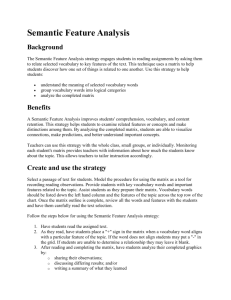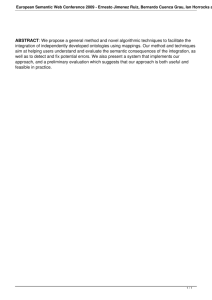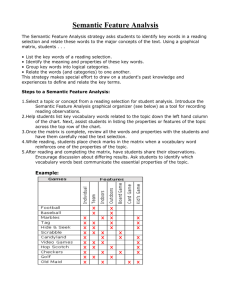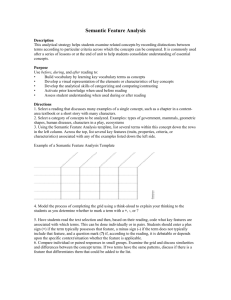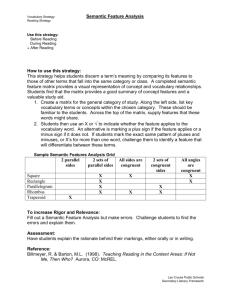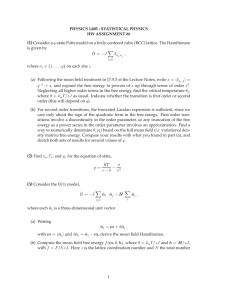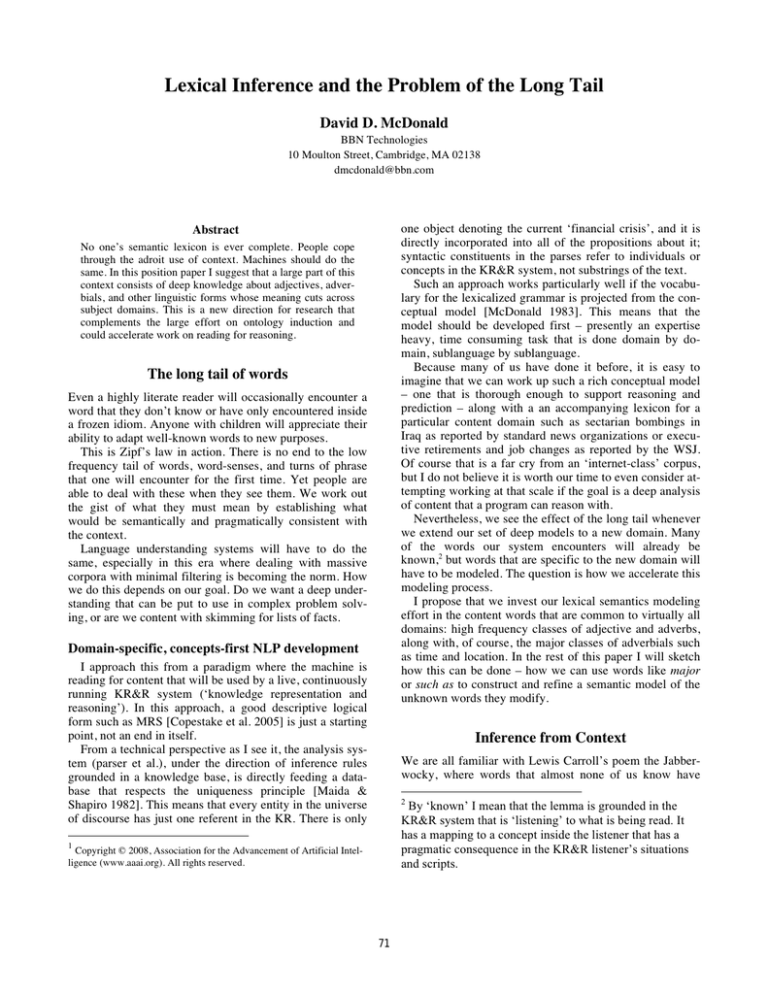
Lexical Inference and the Problem of the Long Tail
David D. McDonald
BBN Technologies
10 Moulton Street, Cambridge, MA 02138
dmcdonald@bbn.com
Abstract1
one object denoting the current ‘financial crisis’, and it is
directly incorporated into all of the propositions about it;
syntactic constituents in the parses refer to individuals or
concepts in the KR&R system, not substrings of the text.
Such an approach works particularly well if the vocabulary for the lexicalized grammar is projected from the conceptual model [McDonald 1983]. This means that the
model should be developed first – presently an expertise
heavy, time consuming task that is done domain by domain, sublanguage by sublanguage.
Because many of us have done it before, it is easy to
imagine that we can work up such a rich conceptual model
– one that is thorough enough to support reasoning and
prediction – along with a an accompanying lexicon for a
particular content domain such as sectarian bombings in
Iraq as reported by standard news organizations or executive retirements and job changes as reported by the WSJ.
Of course that is a far cry from an ‘internet-class’ corpus,
but I do not believe it is worth our time to even consider attempting working at that scale if the goal is a deep analysis
of content that a program can reason with.
Nevertheless, we see the effect of the long tail whenever
we extend our set of deep models to a new domain. Many
of the words our system encounters will already be
known,2 but words that are specific to the new domain will
have to be modeled. The question is how we accelerate this
modeling process.
I propose that we invest our lexical semantics modeling
effort in the content words that are common to virtually all
domains: high frequency classes of adjective and adverbs,
along with, of course, the major classes of adverbials such
as time and location. In the rest of this paper I will sketch
how this can be done – how we can use words like major
or such as to construct and refine a semantic model of the
unknown words they modify.
No one’s semantic lexicon is ever complete. People cope
through the adroit use of context. Machines should do the
same. In this position paper I suggest that a large part of this
context consists of deep knowledge about adjectives, adverbials, and other linguistic forms whose meaning cuts across
subject domains. This is a new direction for research that
complements the large effort on ontology induction and
could accelerate work on reading for reasoning.
The long tail of words
Even a highly literate reader will occasionally encounter a
word that they don’t know or have only encountered inside
a frozen idiom. Anyone with children will appreciate their
ability to adapt well-known words to new purposes.
This is Zipf’s law in action. There is no end to the low
frequency tail of words, word-senses, and turns of phrase
that one will encounter for the first time. Yet people are
able to deal with these when they see them. We work out
the gist of what they must mean by establishing what
would be semantically and pragmatically consistent with
the context.
Language understanding systems will have to do the
same, especially in this era where dealing with massive
corpora with minimal filtering is becoming the norm. How
we do this depends on our goal. Do we want a deep understanding that can be put to use in complex problem solving, or are we content with skimming for lists of facts.
Domain-specific, concepts-first NLP development
I approach this from a paradigm where the machine is
reading for content that will be used by a live, continuously
running KR&R system (‘knowledge representation and
reasoning’). In this approach, a good descriptive logical
form such as MRS [Copestake et al. 2005] is just a starting
point, not an end in itself.
From a technical perspective as I see it, the analysis system (parser et al.), under the direction of inference rules
grounded in a knowledge base, is directly feeding a database that respects the uniqueness principle [Maida &
Shapiro 1982]. This means that every entity in the universe
of discourse has just one referent in the KR. There is only
Inference from Context
We are all familiar with Lewis Carroll’s poem the Jabberwocky, where words that almost none of us know have
2
By ‘known’ I mean that the lemma is grounded in the
KR&R system that is ‘listening’ to what is being read. It
has a mapping to a concept inside the listener that has a
pragmatic consequence in the KR&R listener’s situations
and scripts.
1
Copyright © 2008, Association for the Advancement of Artificial Intelligence (www.aaai.org). All rights reserved.
71
very clear grammatical roles. We deduce their roles by
making inferences from the function words and morphology (in bold).
Discounting the function words and the broadly applicable classes of content words and phrases (countries, announcements by spokesmen), half of the terms are specific
to the domain (stocks, discount window) and will only
make sense to a KR&R program that has a model for them.
The other half of them are terms whose meaning does not
depend on the domain (had already, quell, before the
Xing). We can use the inferences associated with these
domain-independent terms to begin to pin down the meaning of the unknown, domain-specific terms.
This is a position paper, reflecting the fact that I have
programmed only a few examples while awaiting funding.
But let me give a superficial sense of what this crossdomain semantic context lets us conclude. From had already Xed we know that ‘stocks’ refers to an eventuality,
either directly or metonymically. From the fact that
‘stocks’ verbed lower, we know that it is scalar. These are
cases where category constraints associated with the terms
let us ascribe properties to the concept we have formed to
stand for the meaning of the unknown (to the program)
head word stocks. These properties are the basis for its position in the lattice that forms the backbone of our ontology.
More examples. Because the ‘fears’ have to be quelled
we know they already exist. The use of other lets us infer
that ‘the Fed’ and ‘central backs’ are of the same kind. We
can ascribe the ability to ‘lend’ to ‘banks’ because they
may start to do it. From again we infer that they used to do
it. From each other we know that ‘banks’ ‘loan’ to ‘banks’.
(If this sounds odd because you can’t turn off your own
knowledge of finance, try replacing the heads with head
words from Jabberwocky.)
This enterprise is not without pitfalls. Candidates for
context-defining terms must be thoroughly explored and
vetted. Word sense differences are an issue (bank). But if
we are careful about our sources (straight news, not quotes
from politicians), we get qualitative categorial judgments
about the words, something that linguists, particularly cognitive linguists, have done for decades [Talmy 2000]; we
need to do the same computationally.
`Twas [it was] brillig, and the slithy toves did gyre
and gimble in the wabe: all mimsy were the borogroves, and the mome raths outgrabe.
After reading this, we can answer questions like where
the toves were gyring; we know that these toves were
slithy and the borogroves mimsy; and that the mome raths
are/were in the state/activity of outgrabe/ing/ness.
Cross-domain semantic context
We can do the same thing in the semantic domain. We
use knowledge about modifiers and other forms to impose
constraints on the categorization of their heads. The modifiers constituent a context that allows us to position an unknown word in a subsumption lattice. As the same word is
seen in the context of other deeply understood modifiers,
this categorization can be refined: the concept we create for
the word moved further down in the lattice. If multiple
words are observed in the same suite of contexts (appear at
the same or nearby point in the lattice), we can conjecture
they may be synonyms, which is a good point for injecting
human expertise into the process. Axioms or other rules of
inference associated with the organizing concepts in the
lattice establish their meaning within the KR&R.
The basic idea is to treat each (class of) modifier(s) as a
predicate as it would be in MRS or Hobbs Normal Form
[Friedland et al.]. This predicate will define value restrictions on its arguments(s), and will come with a set of inference rules. If we read three swans, we know that whatever
else swans may be, they are something that can be counted;
from majority option we can infer that there is a ‘minority
opinion’ even if we haven’t read about it yet. The space of
categorizations that these value restrictions are drawn from
forms our subsumption lattice. Care in its design and the
design of the inferences pays dividends in the leverage the
context provides.
To get a sense of proportion, lets us look at this paragraph chosen at random1 from the New York Times.
Cross-domain modifiers are in red italics; domain-specific
terms are underlined in blue; broad domain terms in bold
green.
References
Copestake, Ann, Dan Flickinger, Carl Pollard, Ivan Sag. (2005)
“Minimal Recursion Semantics: An Introduction”. Research on
Language and Computation 3:281-332.
Friedland, Noah, David Israel, Peter Clark, Eduard Hovy, Jerry
Hobbs, Rutu Mulkar, Bruce Porter, Ken Barker, Ralph Weischedel, Paul Martin. “Project Mobius: a study on the feasibility of
Learning by Reading. www.noahfriedland.com/uploads/Moebius
_ Final_Report.pdf Downloaded 10/2/2008.
Maida, Anthony & Stuart Shapiro (1982), “Intensional Concepts
in Propositional Semantic Networks”, Cognitive Science 6, pp.
291-330
McDonald, David. (1993) “The Interplay of Syntactic and Semantic Node Labels in Partial Parsing”. Proc. Third International
Workshop on Parsing Technologies, August 10-13, 1993 Tilburg,
The Netherlands, pp. 171-186; revised version in Bunt and To-
In Asia, stocks had already closed lower. To quell
fears before the opening of European markets, the
Fed and other central banks announced they would
make $180 billion available, in an effort to get banks
to start lending to each other again. The Fed had
agreed to open its discount window to make loans
available to money market funds to prevent further
runs.
1
This is the paragraph my eyes first lit on when I looked
up at my browser after deciding I needed a new example.
www.nytimes.com/2008/10/02/business/02crisis.html.
72
mita (eds.), Recent Advances in Parsing Technology, Kluwer
Academic Publishers, pgs. 295-323.
Talmy, Len. Toward a Cognitive Semantics. MIT Press 2000.
73

